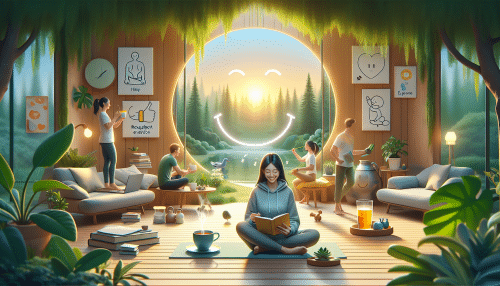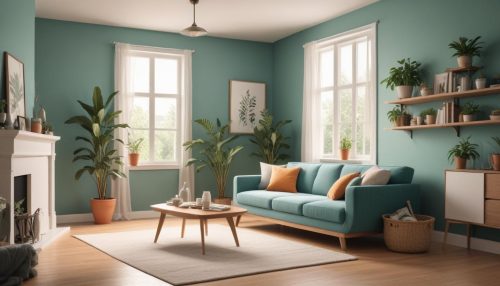Simple Home Decor Changes That Make You Happier
Olivia Morgan August 23, 2025
Explore the lifestyle secrets behind simple home decor changes that can boost your mood and happiness. Learn how lighting, color, and mindful organization can transform the feel of your living space using proven, research-based approaches.
The Science of Mood and Home Design
Home decor does more than just please the eye. Academic research and popular trends show that the design of living spaces can have a positive effect on mental health. Light, color, and the organization of furniture shape our daily feelings. For instance, natural light isn’t only a design preference; it’s linked to serotonin production, which supports emotional well-being. Simple decisions about color schemes and material choices lead to profound psychological outcomes, helping people feel more relaxed and recharged in their daily routines. Numerous design psychology studies, including those from leading universities, suggest that the connection between ambience and happiness shouldn’t be underestimated.https://www.psychologytoday.com/us/articles/201703/how-design-affects-your-mood
There is increasing interest in how interior design can be intentionally crafted to create a calming environment. Designers and homebuilders often use light, open space, and specific colors to influence mood, and recent surveys show that many homeowners prioritize these factors when redecorating. Simple changes, like adjusting window coverings or adding indoor plants, can reduce stress and foster a bright, welcoming atmosphere in the home. This trend is reflected in the growing popularity of wellness-focused living spaces, from city apartments to suburban homes. Design experts recommend thoughtful placement of furniture, maximizing daylight exposure, and adding natural elements for optimal effect.
Minimalism is another significant influence in home decor trends. Removing clutter and maintaining organized living arrangements can make each room feel more spacious, while also reducing anxiety. Research shows that clean, clutter-free spaces help with concentration and alleviate the feeling of being overwhelmed. By redesigning rooms to emphasize openness and simplicity, homeowners can achieve a feeling of ease after a long day. Clean lines, neutral palettes, and orderly shelves contribute to both mental clarity and relaxation, contributing to a happier lifestyle overall.https://www.healthline.com/health/mental-health/decluttering-mental-health
Color Psychology and Emotional Well-Being
Colors play a vital role in shaping the mood of any interior. Blue, for example, often brings calmness while yellow is associated with increased optimism. The field of color psychology reveals how even small decor adjustments, such as changing cushion covers or repainting a wall, can influence positivity. Many people find that certain hues help with energy, creativity, or focus, while others inspire rest and comfort. Choosing the right palette for each room—especially bedrooms, home offices, or lounges—can quietly transform how welcoming and uplifting a home feels.https://www.ncbi.nlm.nih.gov/pmc/articles/PMC4383148/
Experts in lifestyle design recommend thinking about how specific colors affect one’s energy. Cool tones like green and pastel shades generally promote relaxation, perfect for wind-down spaces. In contrast, bolder shades such as orange or magenta can spark lively conversation and creativity in common areas. Those seeking a sense of serenity in the home might gravitate toward a neutral foundation with pops of color through accent pieces, artworks, or plants. This approach strikes a balance between personality and peacefulness, tailored to each household’s unique needs.
Besides paint, color can enter the home in more flexible ways. Textiles, fresh flowers, artwork, curtains, and rugs give opportunities to experiment with trending shades—and swap them out seasonally or as tastes change. Professional decorators often suggest starting with interchangeable elements before committing to permanent paint decisions. Homeowners can then express their ever-evolving styles without major renovations, bringing continuous small positive changes that keep home environments lively and rejuvenating.
Lighting Choices That Lift Spirits
Lighting is central to both decor and mood management. Sunlight pouring in through large windows is a luxury, but creative use of floor lamps, fairy lights, or dimming bulbs makes any interior glow even on gloomy days. Daylight simulation and well-placed ambient lights are shown to enhance alertness and comfort, particularly in darker winter months. Adjustable smart bulbs or layered lighting can provide practical options for every time of day—whether energizing mornings or cozy evenings are the goal.https://www.ncbi.nlm.nih.gov/pmc/articles/PMC6679404/
Flexible lighting layouts let people set the tone in various rooms. Soft white bulbs help bedrooms feel restful and luxurious, while powerful desk lamps make workspaces feel focused. Dimmers make living rooms adaptable for everything from dinner parties to movie nights. Many residents now include smart home devices that enable remote adjustments through apps or voice commands. These upgrades empower users with instant changes to their surroundings, providing mood-boosting control that aligns with daily routines.
Lighting design also includes the creative use of reflective surfaces. Mirrors bounce both daylight and artificial light, making small rooms feel bigger and brighter. Sconces, glass accents, and metallic finishes multiply illumination while acting as trendy decor features. The result is a space that feels airy and open, promoting well-being for everyone who enters. Professional decorators often use this trick to bring visual interest and mood enhancement together in a seamless, low-cost way.
Organization and Mindful Decluttering
Clutter isn’t only about physical items—it can affect the mind as well. Studies report a strong link between organized spaces and increased happiness, especially in busy households. Simple organizational practices provide immediate effects: labeling, storage baskets, and hidden compartments maintain tidiness but also make cleaning routines sustainable. Organizing even one room can inspire momentum to keep the rest of the home harmonious. Decluttering periodically, as lifestyles change, ensures that everything at home contributes to a sense of peace.https://news.stanford.edu/news/2017/october/clutter-can-impact-mental-health-102417.html
Mindful decluttering works hand-in-hand with positive psychology. It invites regular reflection on what truly brings joy, as popularized by various minimalist philosophies. Many find that letting go of unused or excess belongings lightens mental loads, making it easier to focus on activities and relationships instead of chores. This intentional approach often turns cleaning into a rewarding lifestyle practice, one where each item in the home is valued and purposeful.
Technology offers new solutions for home organization as well. With smart storage systems and mobile reminders, keeping things functional is easier than ever. Apps and digital calendars can help coordinate household tasks, reduce mental friction, and make shared spaces more enjoyable for everyone. As a result, homes can feel lighter, more functional, and better suited to modern living—helping to foster greater happiness for all members.
Incorporating Nature Indoors
Natural materials and greenery improve home environments in meaningful ways. Scientific research shows that indoor plants are linked to increased productivity, better air quality, and calmness. From lush ferns in the living room to compact succulents on a desk, bringing nature inside reconnects residents with the outdoors, even in urban settings. Homes that incorporate natural elements tend to feel fresher, revitalizing both body and mind.https://www.rhs.org.uk/science/articles/health-wellbeing-benefits-of-plants
Beyond plants, using raw wood, cotton textiles, and stone finishes can create a sense of earthiness. Even small touches like bamboo trays, woven baskets, or rattan chairs add to this effect, and are worth considering for anyone seeking balance. Many find that natural materials generate comfort and a sense of sanctuary, especially in frequently used spaces like kitchens and entry halls. Such choices also enhance visual interest, as organic textures never go out of style.
For those with limited access to natural light, houseplants adapted to shade work well—think snake plants or pothos. Easy-care greenery lets anyone enjoy the health benefits of nature without high maintenance demands. Setting up a plant corner by a window, or adding a vertical garden wall, helps create a mini oasis that brightens moods day after day. This simple decor adjustment, supported by wellness research, can make a noticeable emotional difference.
Personalizing Your Space With Meaningful Items
Personal touches are at the core of a happy home. While trends shift, what matters most are the objects that resonate with each resident. Framed photos, inherited ceramics, travel mementos, or handmade crafts evoke positive memories and contribute to emotional health. Psychology experts note that cherished items create a sense of belonging, connecting us with favorite experiences or people. Making space for these connections is central to lifestyle happiness.https://www.apa.org/topics/resilience/home-personal-objects
The process of personalizing decor brings other benefits, including self-expression and creativity. Rearranging objects or curating collections gives residents ownership and pride in their environment. Some choose to rotate meaningful artwork, seasonal displays, or accessories to keep the vibe fresh. This ongoing engagement with one’s surroundings encourages constant discovery, boosting both satisfaction and happiness at home.
Even shared living situations benefit from thoughtful personalization. Creating zones for different personalities within a household ensures everyone feels seen and valued. Whether it’s a dedicated desk nook, a favorite reading chair, or a teenager’s gallery wall, meaningful customization helps every person feel at home—supporting positive mental health for all. Ultimately, the power of home decor lies in its ability to reflect and uplift the people within it.
References
1. Psychology Today. (2017). How Design Affects Your Mood. Retrieved from https://www.psychologytoday.com/us/articles/201703/how-design-affects-your-mood
2. Healthline. (2021). Decluttering and Mental Health: How Mess Affects Your Mind. Retrieved from https://www.healthline.com/health/mental-health/decluttering-mental-health
3. Küller, R., Ballal, S., Laike, T., Mikellides, B., & Tonello, G. (2006). The impact of light and colour on psychological mood. Retrieved from https://www.ncbi.nlm.nih.gov/pmc/articles/PMC4383148/
4. Bedrosian, T. A., & Nelson, R. J. (2017). Influence of Lighting on Mood. Retrieved from https://www.ncbi.nlm.nih.gov/pmc/articles/PMC6679404/
5. Stanford News. (2017). How clutter can impact your life. Retrieved from https://news.stanford.edu/news/2017/october/clutter-can-impact-mental-health-102417.html
6. Royal Horticultural Society. (2022). The health and wellbeing benefits of plants. Retrieved from https://www.rhs.org.uk/science/articles/health-wellbeing-benefits-of-plants





